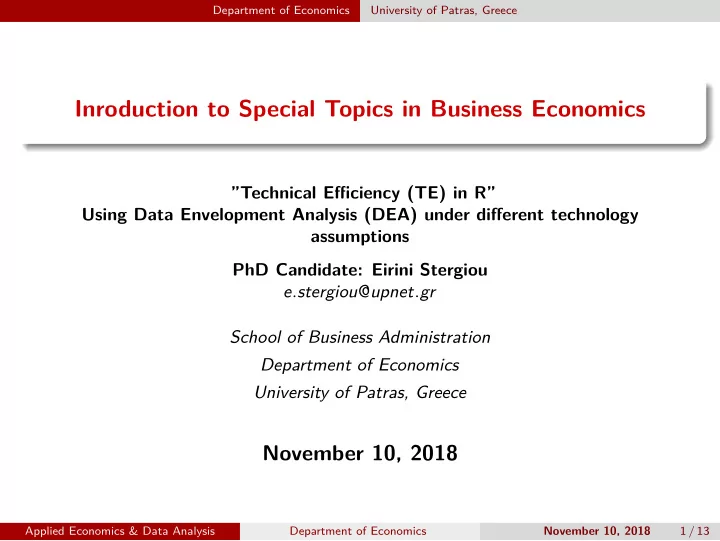

Department of Economics University of Patras, Greece Inroduction to Special Topics in Business Economics ”Technical Efficiency (TE) in R” Using Data Envelopment Analysis (DEA) under different technology assumptions PhD Candidate: Eirini Stergiou e . stergiou @ upnet . gr School of Business Administration Department of Economics University of Patras, Greece November 10, 2018 Applied Economics & Data Analysis Department of Economics November 10, 2018 1 / 13
Department of Economics University of Patras, Greece Structure 1 Efficiency measure Introduction Benchmarking package One Input - One Output Two Inputs - One Output Example with a dataset Applied Economics & Data Analysis Department of Economics November 10, 2018 2 / 13
Efficiency measure Introduction Input orientation:”By how much can input quantities be proportionally reduced without changing the output quantities produced?” Output orientation:”By how much can output quantities be proportionally increased without changing the input quantities used?” CRS - VRS assumption One advantage of the Farrell input and output orientated radial TE measures is that they are units invariant DEA is the non-parametric mathematical programming approach to frontier estimation Charnes, Cooper and Rhodes (1978) proposed a model which had an input orientation and assumed CRS Banker, Charnes and Cooper (1984) proposed a VRS model Second stage of linear programming by maximizing the sum of slacks (e.g. Ali and Seiford (1993)) However some problems occur (furthest efficient point,not unit invariant) Applied Economics & Data Analysis Department of Economics November 10, 2018 3 / 13
Efficiency measure Benchmarking package We use the Benchmarking package It contains an extensive number of methods for parametric and nonparametric efficiency analysis It offers a variety of DEA methods and it is easy to use plotting facilities Applied Economics & Data Analysis Department of Economics November 10, 2018 4 / 13
Efficiency measure One Input - One Output x: Labor y: Sales CRS - calculate the ratio of output to input DMU B has the highest ratio Dividing all ratios by the maximal ratio = ⇒ efficiency scores A B C D E Input x 1.000 2.000 3.000 4.000 5.000 Output y 1.000 3.000 2.000 5.000 4.000 y/x 1.000 1.500 0.667 1.250 0.800 Efficiency 0.667 1.000 0.444 0.833 0.533 We can benchmark all DMUs indexed by i relative to the efficient DMU B 0 ≤ Sales per employee of DMU i ≤ 1 (1) Sales per employee of B Applied Economics & Data Analysis Department of Economics November 10, 2018 5 / 13
Efficiency measure One Input - One Output Figure 1: One input - one output case Applied Economics & Data Analysis Department of Economics November 10, 2018 6 / 13
Efficiency measure One Input - One Output Coding install.packages(”Benchmarking”) library(Benchmarking) emp < − matrix(1:5) sales < − matrix(c(1,3,2,5,4)) nam < − LETTERS[1:5] maxc < − cmax(sales/emp) eff < − sales/emp / max tab < − t(round(cbind(emp,sales,round(sales/emp,3),eff),3)) colnames(tab) < − nam rownames(tab) < − c(”input x”,”output y”,”y/x”,”efficiency”) View(tab) dea.plot(emp,sales,RTS=”crs”,ORIENTATION=”in- out”,pch=19,cex=0.8,txt=LETTERS[1:length(emp)],las=1) Applied Economics & Data Analysis Department of Economics November 10, 2018 7 / 13
Efficiency measure Two Inputs - One Output x 1 : Employees x 2 : Floor area y: Sales CRS Isoquant curve A B C D E Input x 1 4.000 7.000 8.000 5.000 2.000 Input x 2 3.000 2.000 1.000 5.000 5.000 Output y 1.000 1.000 1.000 1.000 1.000 Efficiency 1.000 0.909 1.000 0.700 1.000 The three efficient units A, C, and E serve as the benchmark for the non-efficient DMUs. Applied Economics & Data Analysis Department of Economics November 10, 2018 8 / 13
Efficiency measure Two Inputs - One Output Figure 2: Two inputs - one output case Applied Economics & Data Analysis Department of Economics November 10, 2018 9 / 13
Efficiency measure Two Inputs - One Output Coding x1 < − c(4,7,8,5,2) x2 < − c(3,2,1,5,5) y < − rep(1,5) X < − cbind(x1,x2) Y < − matrix(y) e < − dea(X,Y,RTS=”crs”,ORIENTATION=”in”,SLACK=T) eff(e) plot < − dea.plot.isoquant(x1,x2,txt=LETTERS[1:5], xlim=c(0,10),pch=19,cex=0.8) Applied Economics & Data Analysis Department of Economics November 10, 2018 10 / 13
Efficiency measure Example with a dataset Dataset charnes1981 A data frame with 70 school sites firm: school site number x1: education level of the mother x2: highest occupation of a family member x3: parental visits to school x4: time spent with children in school-related topics x5: the number of teachers at the site y1: reading score y2: math score y3: self - esteem score pft: =1 if in program (program follow through) and =0 if not in program name: Site name Applied Economics & Data Analysis Department of Economics November 10, 2018 11 / 13
Efficiency measure Example with a dataset Coding Reading a file charnes1981 < − read.csv(”C:/Users/Irene/Documents/R/win- library/3.4/Benchmarking/data/charnes1981.csv/charnes1981.csv”, header=TRUE, sep=”;”) x < − with(charnes1981, cbind(x1,x2,x3,x4,x5)) y < − with(charnes1981, cbind(y1,y2,y3)) Phase one: Farrell input efficiency - vrs technology e < − dea(x, y, RTS=”vrs”, ORIENTATION=”in”) peers(e) lambda(e) summary(e) excess(e,x) Phase two: Calculate slacks (maximize sum of slacks) el < − dea(x,y,SLACK=TRUE) Creating a data frame total < − data.frame(e$eff,el$slack,el$sx,el$sy) Saving the efficiency results write.csv(total, file = ”C:/Users/Irene/Desktop/efficiency.csv”) Applied Economics & Data Analysis Department of Economics November 10, 2018 12 / 13
Efficiency measure Example with a dataset References Banker, R. D., Charnes, A., & Cooper, W. W. (1984). Some models for estimating technical and scale inefficiencies in data envelopment analysis. Management science, 30(9), 1078-1092. Charnes, A., Cooper, W. W., & Rhodes, E. (1981) Evaluating Program and Managerial Efficiency: An Application of Data Envelopment Analysis to Program Follow Through. Management Science, 27(6), 668-697. Charnes, A., Cooper, W. W., & Rhodes, E. (1978). Measuring the efficiency of decision making units. European journal of operational research, 2(6), 429-444. Peter Bogetoft and Lars Otto. Benchmarking with DEA, SFA, and R, Springer 2011. Sect. 5.2 page 115 P Andersen and NC Petersen. ”A procedure for ranking efficient units in data envelopment analysis”, Management Science 1993 39(10):1261-1264 https://cran.r-project.org/web/packages/Benchmarking/ Benchmarking.pdf Applied Economics & Data Analysis Department of Economics November 10, 2018 13 / 13
Recommend
More recommend